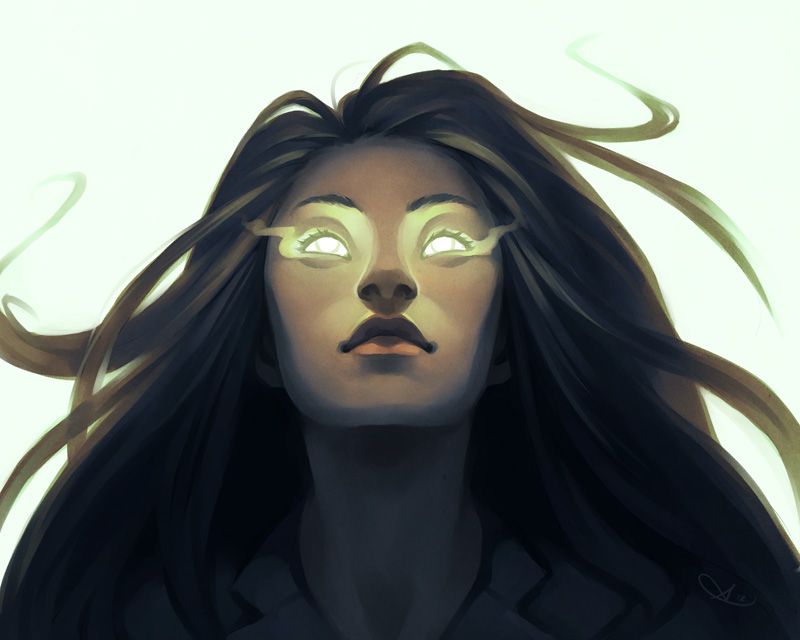
Art by Alexandra Douglass
I’ve mentioned the game of NetRunner off-handedly twice before. Back when I finally got around to sorting all of my old CCG cards, I found I still have my decks for the game. A couple weeks ago, I played the new iteration of the game, and many of its ideas hold up despite the intervening years, even if the game has changed in many significant ways. And it’s kicked some other ideas into overdrive, to the point that I feel I’m on the edge of something very interesting provided I motivate myself to carve out the time and space I need.
Let’s begin at the beginning. The year is 1996. Magic the Gathering had already become a big part of my life, I was heading towards my senior year of high school, and cyberpunk dystopias were now being depicted with true computer-generated graphics, even if the graphics weren’t all that great. Johnny Mnemonic, The Lawnmower Man, and Hackers were all fresh in the minds of those on the edge of the digital frontier, and Wizards of the Coast, no fools but their own, published a new Deckmaster game aimed at this emerging demographic. But rather than simply slap a coat of pixelated paint on Magic and call it a day, they tried something new.
While cribbing notes from R. Talsorian’s Cyberpunk 2020 game, Richard Garfield also envisioned an asymmetrical play environment. The game has two players. One represents the Corporation, a monolithic capitalist juggernaut bent on turning profits by any and all means necessary, advancing hidden agendas that increase their influence over anyone within reach of their advertisements. The other is the Runner, a hacker extraordinaire hurling themselves into the unknown wilds of security systems to spy on, destroy, or steal anything they can, especially from Corporations. Both players win by scoring a set amount of agenda points, but the Corporation is the only player with said points in their deck. The Runner has to steal them, and that means breaching the Corp’s defenses.
On top of this interesting foundation is the element of hidden information. The Corporation sets up their side of the table with cards that represent their remote servers, using programs for interdiction called ICE to stop the Runner from getting to whatever information they want to protect. Their hand, deck, and discard pile also count as servers, and are also viable targets for the Runner. ICE, remote server assets, the precious agendas – all of these cards are played face-down by the Corporation. The Runner, more often than not, will not know what the face-down card is until the Corporation chooses to pay the cost required to reveal it. The Corporation relies on careful planning, deception, and the intimidation of utter brutality in response to intrusion; the Runner is fueled entirely by intelligence, courage, and more than a little luck.
Unfortunately for Mr. Garfield, NetRunner never really took off the way Magic did. It faded into relative obscurity and was battered around as an IP a bit before Fantasy Flight Games came across it while developing their Android universe of tabletop games. Now, rather than their identities being amorphous and generic, players build their decks around an identity, a persistent aspect that grants a bonus throughout the game and helps drive the focus of their strategy. Are you looking to achieve victory as quickly as possible through the traditional means of scoring agenda points? Do you have a more nefarious aim, such as doing as much damage to the Runner as possible, or making all of the Corp’s ICE extremely brittle? Or is your aim just to watch the dystopia burn?
The game has also changed in that rather than being a collectible card game, it is now what is referred to as a living card game. Instead of randomized booster packs, the game is available as a core set with several ‘data packs’, and each one contains the same amount of the same cards. This levels the playing field for competition, makes it a touch easier to teach, and ensures that as the game ages, older cards have less of a chance of becoming either obsolete or overpowered. In addition, the core set includes a plethora of counters and markers (or as I call them, “FFG fiddly bits” as Fantasy Flight Games loves its cardboard punch-outs) that are a welcome addition, as the old game required you to track things like credits, memory, and so on with coins, jelly beans, or whatever else you had handy. Top it off with some breathtaking art, a comprehensive rulebook, and high-quality cards, and you have one of the most successful resurrections of an older game I’ve ever seen.
I hope to eventually find more local players of the game, or failing that, convert some people I know to it. The future is coming…



Leave a Reply